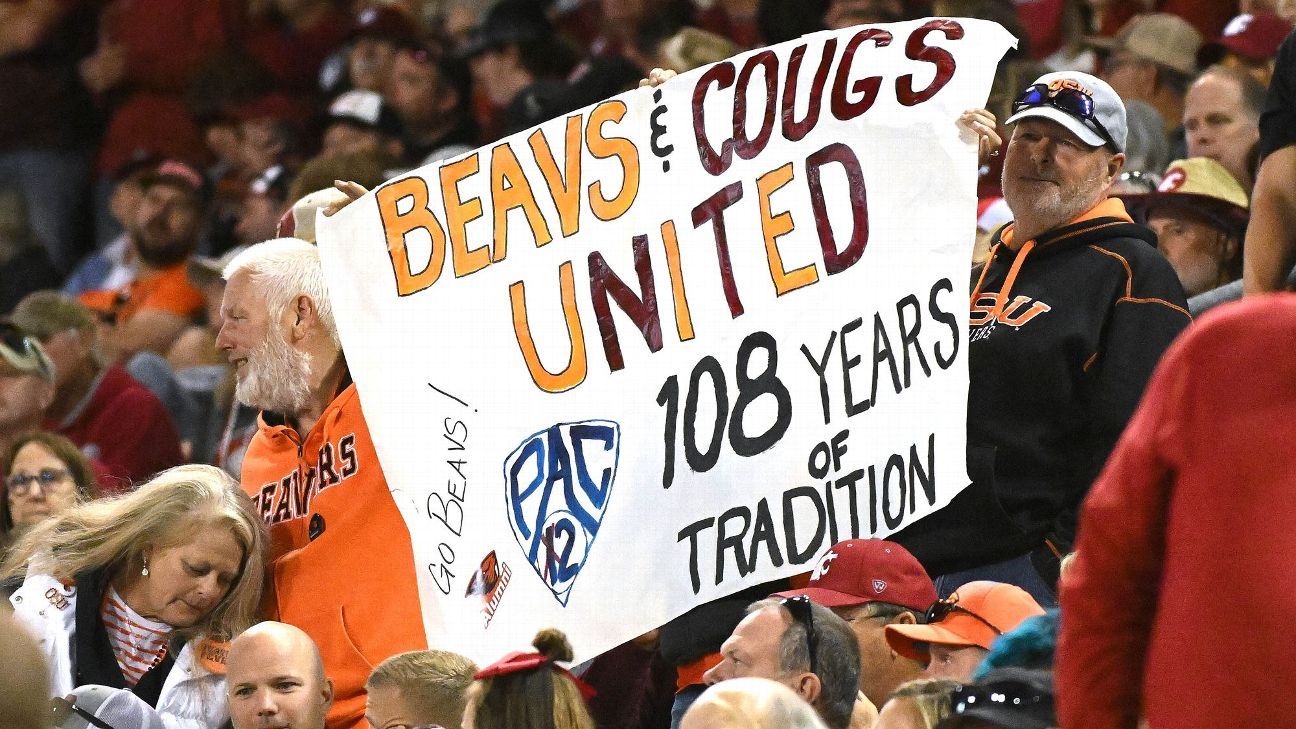How WSU and OSU are benefitting financially from Pac-12’s NCAA men’s tournament wins
Jon WilnerMarch 23, 2024 at 4:14 pm
The past seven months have produced a barrage of highs and lows for Washington State and Oregon State, the schools left behind in the realignment game.
The Pac-12’s demise in August was followed by the football season, the laborious but ultimately successful legal fight against the 10 departing schools, scheduling arrangements with the Mountain West and West Coast Conference and, finally, two very different experiences for the respective men’s basketball programs.
But for plot twists and emotional turns, the eight days that concluded Friday are tough to beat. The stretch began with crushing news and a bleak financial situation and ended with an unexpected pot of cash.
The schools improved their financial situation by more than $30 million in that short timeframe.
Let’s recount the eight days, step by step.
March 15
It was anything but a quiet Friday as late-morning media reports sent shockwaves through Pullman and Corvallis.
The College Football Playoff’s revenue distribution model, which allocated varying amounts to the conferences, had relegated WSU and OSU to fourth-rate status.
The two schools were treated as Independents and reportedly assigned annual shares of $360,000 each for the six years of the contract cycle (2026-31).
That was just 20 percent of the $1.8 million shares negotiated for each Group of Five school (think: Boise State, Tulane, Akron, etc.), and it was roughly 95 percent less than the amount WSU and OSU collect currently as members of the Pac-12.
This, while every other FBS school would receive a substantial increase in CFP revenue from the new, $1.3 billion annual deal with ESPN.
Multiple industry sources were aghast at the treatment of the two schools.
Meanwhile, the semifinals of the Pac-12 tournament were scheduled for that evening, with Arizona facing Oregon and Washington State playing Colorado.
The financial outlook for WSU and OSU on the court? Somewhat gloomy.
Victories by the top-seeded Wildcats and second-seeded Cougars likely would result in the conference sending only those two teams to the NCAA Tournament.
With each March Madness game carrying a value of $2 million in future revenue, the semifinal pairings suggested two bids for the conference and, therefore, just $4 million in guaranteed cash for the ‘Pac-2’ schools.
March 17
By Friday night, the on-court outlook had improved dramatically, with victories by Colorado and Oregon pushing the Pac-12 closer to additional berths.
When the brackets were revealed on Selection Sunday, the conference had secured four bids — the maximum available under the circumstances.
Oregon claimed the automatic bid (by winning the tournament) while Colorado joined Arizona and WSU in the at-large field, albeit barely. The Buffaloes were the third-to-last team voted into the event.
Even if all four schools lost their NCAA openers, the Pac-12 would have four units at $2 million each. The Cougars and Beavers were now guaranteed $8 million in future revenue.
March 19
A double dose of good news arrived Tuesday.
First, the College Football Playoff revenue distribution model was finalized, and — presto! — it featured larger shares for WSU and OSU. Substantially larger shares, in fact.
Instead of just $360,000 per school per year for six years, the Cougars and Beavers would collect $3.6 million annually for the first three years (2026-28) of the contract.
Exactly what was said in the private discussions between Pac-12 commissioner Teresa Gould and her colleagues remains a mystery. But the end result was a 10-fold increase for the Cougars and Beavers during the first half of the contract term. (The distributions for the final three years are unknown.)
But an increase in CFP revenue wasn’t the only encouraging development Tuesday for WSU and OSU.
Thunderous news surfaced in the ACC, where Clemson filed a lawsuit against the conference in an attempt to invalidate the grant-of-rights contract holding the ACC together.
The lawsuit came three months after the ACC’s other football powerhouse, Florida State, initiated legal proceedings against the conference.
Sponsored
The lawsuits make different claims, but the end goal is the same: The Tigers and Seminoles want to obliterate the ACC’s contract so they can pursue membership in the SEC or Big Ten.
And anything that creates more realignment at the power conference level is good news for the Cougars and Beavers.
If the ACC dissolves, Cal and Stanford, which are scheduled to enter the conference this summer, might be forced to join Washington State and Oregon State in rebuilding the Pac-12.
If the ACC dissolves, the Big 12 might become a receptacle for all schools that don’t gain membership in the Big Ten or SEC.
If the ACC dissolves, the top football schools in every conference could form a super league of 24 or 32 teams and leave everyone else behind — thus placing WSU and OSU on the same level as dozens of second-tier football schools that are currently in the ACC, Big 12, Big Ten and SEC.
Uncertainty over the structure of the sport is the building block of the ‘Pac-2’ strategy: Remain as flexible as possible for as long as possible in case everything crumbles and opportunities surface.
There was even better news for WSU and OSU the next day, March 20, when the chair of North Carolina’s Board of Trustees told Inside Carolina: “I think that what Clemson is doing is 100 percent proof positive that a significant portion of the (ACC) membership of the conference is unhappy.”
March 21-22
The start of March Madness brought more good news for the Cougars and Beavers, as all four Pac-12 teams won their first-round games. Add Colorado’s victory in the First Four, and the conference was guaranteed at least nine games.
With each game (i.e., unit) equalling $2 million over the course of the six-year payout window, the ‘Pac-2’ schools were suddenly staring at $18 million in guaranteed cash — a huge uptick from the situation as it stood prior to the semifinals of the Pac-12 tournament.
In fact, the NCAA Tournament results and the change in College Football Playoff revenue produced a windfall for WSU and OSU over just eight days.
Here’s our back-of-the-envelope math:
— How it looked on March 15
NCAA Tournament revenue: With only two teams assured of making the field (two units), the conference could count on just $4 million.
CFP revenue shares: With $360,000 annual shares over six years for two teams, that meant just $4.3 million for the Pac-12 coffers.
Total: $8.3 million.
— How it looked on March 22
NCAA Tournament revenue: With four teams winning five games (nine units), the conference is guaranteed at least $18 million.
CFP revenue shares: With $3.6 million annually for three years for two teams, the total climbs to $21.6 million.
Total: $39.6 million
In other words, Washington State and Oregon State increased their guaranteed revenue by $31.3 million from Friday morning of one week to Friday night of the next.
And the total will grow by $2 million with each subsequent NCAA victory. (Arizona defeated Dayton on Saturday, pushing the unit count to 10.)
That said, the NCAA revenue is contingent on Pac-12 survival. If the conference dissolves or if it becomes a different legal entity, a source said, the revenue earned this month will be split evenly among the 12 current schools, regardless of future conference affiliations.
Also, any additional members of the Pac-12 — if we assume WSU and OSU pursue expansion in some form — might attempt to negotiate access to a portion of the NCAA units.
And it’s unclear how the CFP would handle revenue distributions if a Pac-8 or Pac-10 were to emerge in a few years, with schools from the Mountain West or other conferences.
The past eight days did nothing to solve the riddle of what comes next for WSU and OSU. But the wild week clearly unfolded in a favorable, and lucrative, fashion for the two schools.
Jon Wilner:
jwilner@bayareanewsgroup.com; Jon Wilner has been covering college sports for decades and is an AP top-25 football and basketball voter as well as a Heisman Trophy voter. He was named Beat Writer of the Year in 2013 by the Football Writers Association of America for his coverage of the Pac-12, won first place for feature writing in 2016 in the Associated Press Sports Editors writing contest and is a five-time APSE honoree.



